Home
Inetnon Manggåfa: Såkkan 2014 (2014 Family Reunions)
- Details
- Written by: Bernard Punzalan

Now is the time start planning to attend! For those abroad here’s a goal and challenge to attend and be a part of family celebrating with family!
Manggåfan Liberato
When: February 23, 2014, 10am - 5pm
Where: Ipao Beach Park
Contact: Roland Blas (
The Manggåfan Liberato are descendants of their patriarch Jose Liberato Guerrero (1840-?) who married Maria Pangelinan Flores, Manggåfan Kotla (1844-?). Jose Liberato was a Spanish soldier who settled on Guam. Together with Tan Maria, they had nine children.
Manggåfan Tugong
When: March 16, 2014, 10am-5pm
Where: Ipao Beach Park
Contact: Roland Blas (
The Manggåfan Tugong’s patriarch is Mariano Palomo Blas (1844-?) who married Josefa Borja Farfan (1844-?). They had at least five sons and one daughter. According to Roland Blas, his oral family history conveys that Tun Mariano was a great fisherman who was well known. Roland’s grandma described her father Mariano as tall and well built. He was also a canoe builder and when he paddled on the waters he was very fast, this is how he got the nickname Tugong.
By definition Tugong means to charge, attack, or take hold of.
Manggåfan Acfalle
When: July 12, 2014
Where: Malesso Pier/Recreation Center Park
Contact: Melba Soriano Acfalle (
The surname Acfalle (akfåyi) is one of the surviving indigenous Chamorro surnames with a positive meaning. The root word is fåyi, which means wise.
While collaborating with Joseph Maguadog Acfalle and Melba Soriano Acfalle on the Acfalle families, there seem to be five or six main branches of the Acfalle families. The majority originate from Malesso. However, I have noted that at least one Acfalle family resided or farmed in Hågat during the 1800’s. Interestingly, there is an unmarried male by the name of Vicente Acfayi from the village of Hågat that was recorded in the 1727 Census.
Five of the main Acfalle clans that we have been able to identify include the descendants of:
- Jose Santiago Acfalle (abt. 1770-?) married to Rosa Rabago (abt 1770-?).
- Chiquito Acfalle (abt. 1790-?) in 1810 married to Rosa Robago (abt. 1790-?)
- Macedonia Acfalle (abt 1780-?) married to Juan Chargualaf (abt 1780-?)
- Nicolas Acfalle (abt. 1820-?) and Rita Chargualaf (abt.1820-?)
- ? Acfalle (abt, 1840-bef 1897) married to Irene de San Nicolas (1840-?) (this family has records of residency in Hågat)
Know of any other reunions? Share it, munga na ma'malao!
Database Update 17 Aug 2013
- Details
- Written by: Bernard Punzalan
The database has been updated and has grown from 299,033 to 299,888 names.
Håle’ Cruz
- Details
- Written by: Bernard Punzalan
Manggåfan Cruz (Some Family Clan Names)
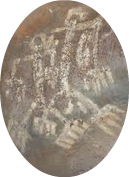 Because the Cruz surname is so widespread, many families are alternately known by their clan names[1]. In my research and observations I have noted that the following clan names are associated with the Cruz surname:
Because the Cruz surname is so widespread, many families are alternately known by their clan names[1]. In my research and observations I have noted that the following clan names are associated with the Cruz surname:
|
Anåco |
Cann |
Jeje (Yeye) |
Robat |
|
Andai |
Chåda |
Koho |
Sato' |
|
Apigige' |
Chåla |
Lala |
Sungot |
|
Båchet |
Chande' |
Lasaro |
Talo |
|
Bana |
Che'le |
Lasso |
Tanåguan |
|
Batolu |
Dando |
Lay |
Tanåyan |
|
Baurik |
Finine' |
Meritdo |
Tankaru |
|
Bayik |
Fungo |
Paite' |
Terao |
|
Beja |
Gaga |
Pakakang |
Tuba |
|
Bete |
Galaide |
Pedang |
|
|
Bila |
Gutgoho |
Pinchang |
|
|
Bisko |
Jai (Yai) |
Pulan |
I Na’an Cruz (Some Background on the Cruz Name)
The surname Cruz is one of the most common surnames throughout the Mariana archipelago. For sure in the 1920 and 1930 Census it was the most common surname. My data sampling from the 1940 Census seems to suggest it remained the same.
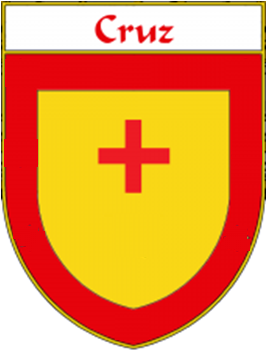 In some literature I have read that the Spanish surname Cruz was derived from a place where the original bearer of the name lived or held his land. However, in general I have observed the Cruz surname to be associated with the “cross.”
In some literature I have read that the Spanish surname Cruz was derived from a place where the original bearer of the name lived or held his land. However, in general I have observed the Cruz surname to be associated with the “cross.”
The Cruz surname is well tied to Spanish origins, but does not necessarily mean that in the history of the Mariana Islands that every Cruz came from Spain. In fact many Spanish soldiers that came to the Mariana Islands came from either New Spain (Mexico) or were born and raised in the Philippines. In addition, during the Spanish occupation, they had a contingent company of Filipino soldiers. Some of these Filipino soldiers and Missionary assistants also had the surname Cruz.
By the late 1600’s, as the Chamorro-Spanish wars were ending, the Missionaries had observed that intermarriages started to take place between the Spanish and Filipinos with the Chamorro women. Also of note during this period and through the 1897 Census, it seems that women in general (regardless of ethnicity) did not assume the husband’s surname upon marriage. Well, at least women's maiden names were how they were recorded. This form of practice does help some fellow genealogists to identify matrilineal lines of ancestry. Unfortunately, there are still huge gaps in detailed census periods.
In the 1727 Census, there were 34 people recorded with the Cruz surname, 92 in the 1758 Census, and then in the 1897 there were 665. When the U.S. took over and beginning in the 1920 Census there were 903 people recorded with the Cruz surname and then 1,231 were recorded in the 1930 Census.
Interestingly, the matriarchs of the two primary Chamorro-Scottish Anderson families in the Mariana Islands are Cruz. Josefa dela Cruz who married John Anderson in 1819, and nearly one hundred years later, Rosa Santos Cruz (Mangåffan Tanåguan) who married Arthur Gifford Anderson around 1911. Amazing, Tan Rosa (below) lived to be 104 years old.

I Manggåfa-hu (My Cruz Family Relations)
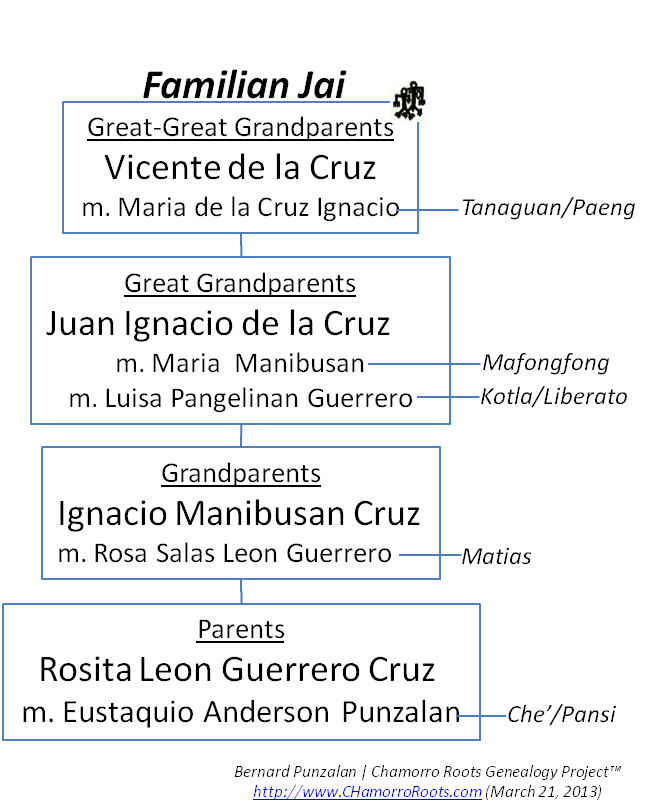
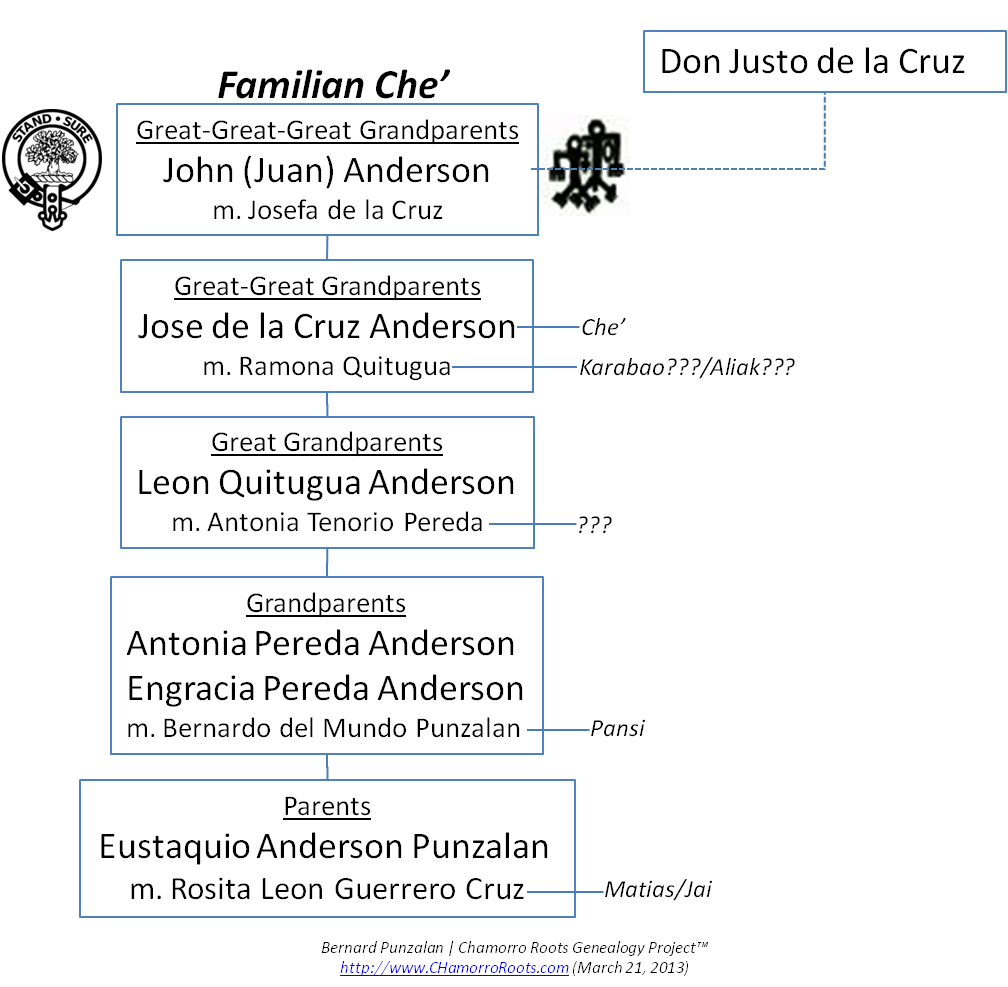
Pues, håyi manggåfa-miyu? Fan oppe!
Manggåfan Båli Tres
- Details
- Written by: Bernard Punzalan
I often wondered about the Manggåfan Båli Tres clan name. It seems to have a meaning with something being worth or having a value of three.
In Laura Thompson’s 1932 manuscript, “Archaeology of the Marianas”, she wrote:
“BALITRES, an ancestor of this family was the illegitimate offspring of a Spaniard by that name (Spanish).”
In the Chamorro Roots Genealogy Project database, the Manggåfan Båli Tres is prevalently tied to a Santos surname. There is much difficulty in tracing ancestral relationships with the Santos surname. It is widespread just like the Cruz surname. In fact, in both the 1920 and 1930 census for Guam, Santos was the second most common surname after Cruz. So in tracing one's Chamorro lineage, knowing the clan name does help quite a bit to narrow down the possible relationship matches.
In Tumon, there is a Tun Luis Bali Tres Street. I wonder if the honored Tun Luis is the same Luis Santos who married Ana Perez. I don’t have birthdates or dates of deaths, but I estimate their birth years to be in the early to mid 1800’s. They had at least one daughter: Andrea Perez Santos (1889-1966) who was married to Rosauro Ulloa Aguon (1877-1952, Manggåfan Makaka).
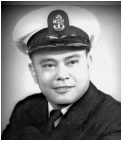 If some of the names above sound familiar, perhaps you may have tuned into the 671 Recipes group on Facebook, where the late Pedro Santos Aguon (1919-2012), a.k.a. “Pop” served as a mentor and advisor to the group’s management and administrative team. Tun Pedro was also a decorated World War II Navy veteran and Pearl Harbor survivor. We were so blessed to have his family, through his daughter Arlene, share his presence and wisdom with us on Facebook.
If some of the names above sound familiar, perhaps you may have tuned into the 671 Recipes group on Facebook, where the late Pedro Santos Aguon (1919-2012), a.k.a. “Pop” served as a mentor and advisor to the group’s management and administrative team. Tun Pedro was also a decorated World War II Navy veteran and Pearl Harbor survivor. We were so blessed to have his family, through his daughter Arlene, share his presence and wisdom with us on Facebook.
I grew up in Tamuning and do remember several of the Santos families in Tumon. But I am not certain if all those that I knew where of the Manggåfan Båli Tres. Perhaps family members will chime in and offer their story about Tun Luis Båli Tres Street or even more about their clan name.
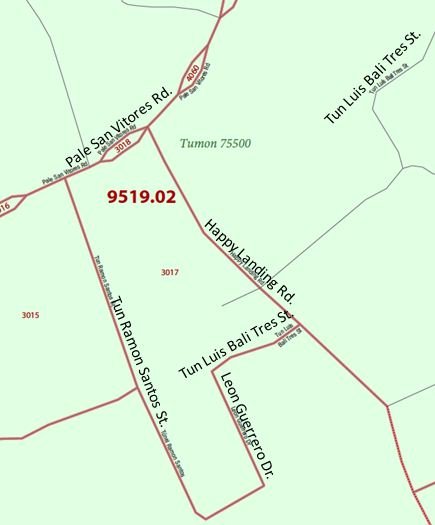
Here’s a funeral announcement of the late Juan Santos Tenorio (1916-1986) who was from Tumon and I do know some of the members of his family.
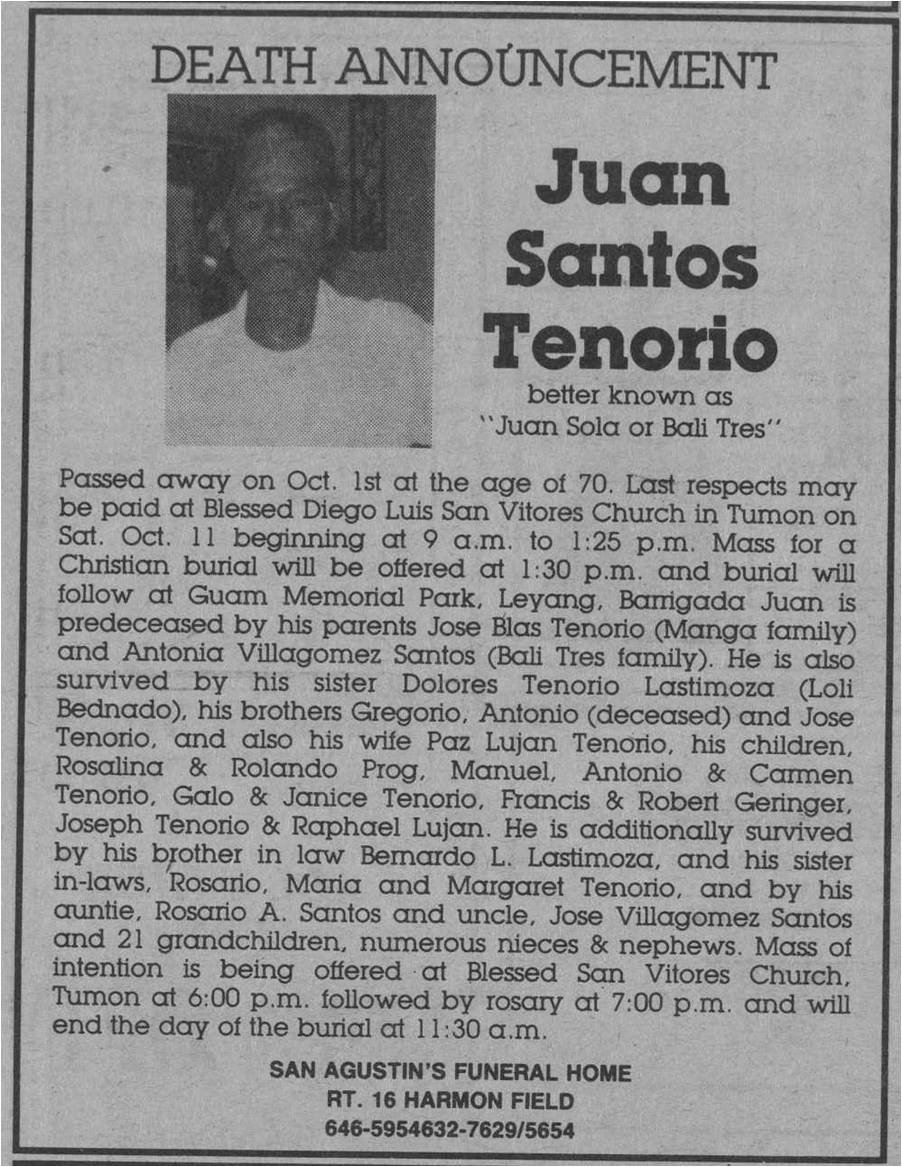
Manggåfan Alimåsak
- Details
- Written by: Bernard Punzalan
Within the Chamorro Roots Genealogy Project™ database, the Manggåfan Alimåsak can be traced to some descendants with Leon Guerrero surname. The oldest level of the Manggåfan Alimåsak I have found so far can be traced to the descendants of Juan Jose de Leon Guerrero (1867-?) and Ana Delgado Sablan (Manggåfan Donggat: 1874-?).
(As of this writing I was unable to confirm if this Juan may be the same person as Juan Jose Borja de Leon Guerrero, son of Juan Jose de Leon Guerrero (b. abt 1832) and Vicenta Iglesias de Borja (1836-?).)
From Anthony Ramirez’ previous research “Chamorro Nicknames,” he found that the Manggåfan Alimåsak is also tied to some people with the San Nicolas surname. I am uncertain at this point if the San Nicolas and Leon Guerrero families with the Manggåfan Alimåsak if there may be any direct lineal relationships with each other or if the same clan names are purely coincidental.
References
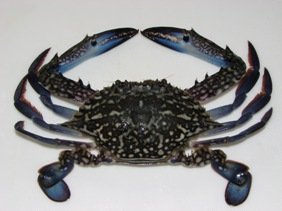 Ramirez also notes that alimåsak refers to a crab. Interestingly, while performing a quick search on the internet, the term “alimasag” pops up and is also a Tagalog word mostly referring to a blue crab.
Ramirez also notes that alimåsak refers to a crab. Interestingly, while performing a quick search on the internet, the term “alimasag” pops up and is also a Tagalog word mostly referring to a blue crab.
In Pale’Eric’s blog, "FAMILY NICKNAMES : ALIMÅSAK" he writes:
"The story I heard says that one of the family ancestors had a little too much of the good stuff to drink, and was with others socializing on the beach. When he got up to walk, he didn't have much of a balance and started to sway to and fro as he walked. This reminded the others of the way the alimåsak walks sideways, and they laughed and started calling him alimåsak."
ADDED 6 August 2013:
In Laura Thompson, “Archaeology of the Marianas” (1932), she recorded the following nickname”
“ALIMASAG, Crab (Zosimus aeneus). A male ancestor of this family was dancing at a gathering and was rather clumsy with his arms. Another man made fun of him, saying: “You dance funny, you hold your arms like an Alimasag.” This is how he got his name.”
Land Record
In a 1901 Guam land record (Estate No. 925) Don Juan Jose de Leon Guerrero filed a petition to formalize his ownership for a parcel of “coconut land located in the Santa Rosa,” that was ceded to him around 1895, by his father-in-law, Vicente Sablan, without an inscribed title to the property.

(Observation Note: This type of land transaction was not uncommon for a person to petition the court due to the lack of an inscribed property title when a land transaction was previously made. In some land records under the Spanish government and early U.S. government, Chamorro nicknames were signified with an "alias" (clan name) followed by the person's name. This land record did not record Don Juan Jose's alias.)
Descendant
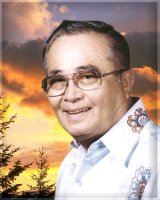 According to a funeral announcement, Francisco Pangelinan Leon Guerrero is a grandson of Don Juan Jose de Leon Guerrero. Francisco was born on April 6, 1926 and passed away on August 1, 2005. His parents were Vicente Sablan Leon Guerrero and the former Nieves Unpingco Pangelinan (Manggåfan Mali’).
According to a funeral announcement, Francisco Pangelinan Leon Guerrero is a grandson of Don Juan Jose de Leon Guerrero. Francisco was born on April 6, 1926 and passed away on August 1, 2005. His parents were Vicente Sablan Leon Guerrero and the former Nieves Unpingco Pangelinan (Manggåfan Mali’).
Page 61 of 81

